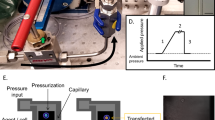Abstract
The problem of the low efficiency of mammalian cloning is discussed with emphasis on the need of expert assessment of every step in single cell reconstruction, beginning with microsurgical manipulations. Experimental proof is provided for the impairment of cell integrity upon its fixation for microsurgery by the negative pressure in a conventional holding pipette. The ensuing leakage of the cell contents is shown to depend on the value of negative pressure, the duration of holding, and the size of the holder orifice. An alternative method of cell fixation is proposed, taking advantage of the capillary forces in the holding micropipette. This reduces the holding effort by two orders of magnitude and raises the cell survival upon microsurgery at least to 92%. To alleviate cell damage by instrumental invasion, a new technique is proposed for making micropipettes. Another novel method is offered for pipette filling with viscous liquid such as DNA solution, which allows continuous injection of more than 1000 cells.
Similar content being viewed by others
References
R. S. Prather, Proc. Soc. Exp. Biol. Med. 195, 7 (1990).
K. Illmensee, Differentiation. 69, 167 (2002).
K. L. Tamashiro, T. Wakayama, H. Aktsu, et al., Nat. Med. 8, 262 (2002).
N. Ogonuki, K. Inoue, Y. Yamamoto, et al., Nat. Genet. 30, 253 (2002).
Y. Tsunoda and Y. Kato, Differentiation 69, 158 (2002).
T. Wakayama, A. C. Perry, M. Zuccotti, et al., Nature 394, 369 (1998).
L. Picard and K. Betteridge, in Animal Biotechnology, Comprehensive Biotechnology (First Suppl), Ed. by M. Moo-Yong, L. Babiuk, and J. Phillips (Pergamon Press, Oxford, 1989), pp. 141–178.
T. Williams and G. Seidel, in Proceedings of Owners and Managers Worshop, IETS IX Annual Conference, 1983, pp. 33–52.
T. J. Williams, R. P. Elsden, and G. E. Seidel, Theriogenology 22, 521 (1984).
D. Murphy and J. Hanson, in DNA Cloning, Vol. III, A Practical Approach, Ed. by D.M. Glover (IRL Press, Oxford, Washington DC, 1987), pp. 213–248.
T. P. Lin, Nature 216, 88 (1967).
P. Talbot and P. Dandekar, Microsc. Res. Tech. 61, 349 (2003).
C. F. Garin, H. Heras, and R. J. Pollero, J. Exp. Zool. 6, 307 (1996).
R. P. Kapur and L. V. Johnson, Anat. Rec. 221, 720 (1988).
T. Hoodbhoy and P. Talbot, Mol. Reprod. Dev. 39, 439 (1994).
K. L. Shephard, Comp. Biochem. Physiol. C. 86, 383 (1987).
T. Raz and R. Shalgi, Hum. Reprod. Suppl. 4, 133 (1998).
J. W. Gordon, Methods Enzymol. 225, 207 (1993).
V. A. Bondarev, E. G. Ivanov, V. A. Nikitin, Yu. A. Popov, and A. M. Khokhlov, USSR AC No. 1616680, Byull. Izobret. No. 48 (1987).
K. Illmensee and P. C. Hoppe, Cell 23, 9 (1981).
J. E. Celis, Biochem. J. 223, 281 (1984).
V. A. Nikitin, Manufacture of Microinstruments for Cell Studies (ONTI NTsBI AN SSSR, Pushchino, 1986) [in Russian].
V. N. Larin, V. A. Nikitin, A. M. Khokhlov, A. L. Byzov, and I. N. Pigarev, USSR AC No. 966043, Byull. Izobret. No. 38 (1982).
A. S. Ginsburg, Methods of Developmental Biology (Nauka, Moscow, 1974) [in Russian].
R. D. Allen, Exp. Cell Res. 6, 403 (1954).
W. Ansorge, Exp. Cell Res. 140, 31 (1982).
W. Ansorge and R. Pepperkok, J. Biochem. Biophys. Methods 16, 283 (1988).
M. R. Capecchi, Cell 22, 479 (1980).
D. Freifelder, Physical Biochemistry. Applicationof Physicochemical Methods in Biochemistry and Molecular Biology (Mir, Moscow, 1980).
N. N. Krasikov, N. F. Efremov, and O. G. Us’yarov, Electrosurface Phenomena in Disperse Systems (Nauka, Moscow, 1972) [in Russian].
D. Perez-Mongiovi, C. Beckhelling, P. Chang, et al., J. Cell Biol. 150, 963 (2000).
A. H. Sathananthan, Histol. Histophathol. 12, 827 (1997).
D. Solter, Nat. Rev. Genet. 1, 199 (2000).
J. B. Gurdon and J. A. Byrne, Proc. Natl. Acad. Sci. USA 100, 8048 (2003).
Author information
Authors and Affiliations
Additional information
Original Russian Text © V.A. Nikitin, E.E. Fesenko, 2006, published in Biofizika, 2006, Vol. 51, No. 4, pp. 673–678.
Rights and permissions
About this article
Cite this article
Nikitin, V.A., Fesenko, E.E. The biophysical aspects of reconstructing a single cell by the methods of cell engineering. BIOPHYSICS 51, 615–619 (2006). https://doi.org/10.1134/S0006350906040154
Received:
Issue Date:
DOI: https://doi.org/10.1134/S0006350906040154




